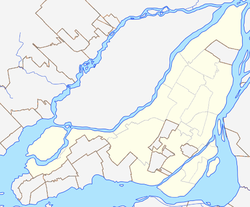Griffintown
| Griffintown | |
|---|---|
| Neighbourhood | |

Mountain Street in Griffintown
|
|
| Location of Griffintown in Montreal | |
| Coordinates: 45°29′15″N 73°34′00″W / 45.48756°N 73.56677°W | |
| Country | Canada |
| Province | Quebec |
| City | Montreal |
| Borough | Le Sud-Ouest |
| Area | |
| • Land | 1.31 km2 (0.51 sq mi) |
| Elevation | 20 m (70 ft) |
| Population (2011) | |
| • Total | 6,446 |
| • Density | 4,920.6/km2 (12,744/sq mi) |
| • Change (2006-11) |
|
| • Dwellings | 4,714 |
Griffintown is the name given to the southwestern downtown part of Montreal, Quebec, which mainly existed from the 1820s until the 1960s and was mainly populated by Irish immigrants and their descendants.
One can identify Griffintown as the portion of the ward of St. Ann located north of the Lachine Canal; the part south of the canal is now part of Pointe-Saint-Charles. This part of the ward was delimited by Notre-Dame Street to the North, the Bonaventure Expressway to the east, and a short segment of the city limit between Notre-Dame Street and the canal west of the St. Gabriel Locks to the west. It was the earliest and largest faubourg annexed to Old Montreal before the introduction of the tram car in the 1840s.
The name Griffintown was derived from Mary Griffin. Griffin illegally obtained the lease to the land from a business associate of Thomas McCord in 1799. She then commissioned land surveyor Louis Charland to subdivide the land and plan streets for the area in 1804. Griffin's husband, Robert, owned a soap manufactory in the area and went on to become the first clerk of the Bank of Montreal upon its formation in 1817.
Griffintown was first populated in the early nineteenth century mostly by Irish immigrant labourers. They worked on the Lachine Canal and the industries surrounding it, the Victoria Bridge, railways, and the Port of Montreal.
The Irish community was centered on St. Ann's Catholic Church, which opened in 1854 at the corner of McCord (now Mountain Street) and Basin Streets, across from Gallery Square, which was named after the Gallery brothers, John Daniel Gallery, who ran a large and successful bakery and his brother Daniel Gallery who was an alderman of Montreal, Schools commissioner and a Liberal member of parliament.
By the early twentieth century, the Irish were being replaced by Jewish, Italian, Ukrainian, and Francophone communities, with the Irish becoming a minority group by 1941.
...
Wikipedia

